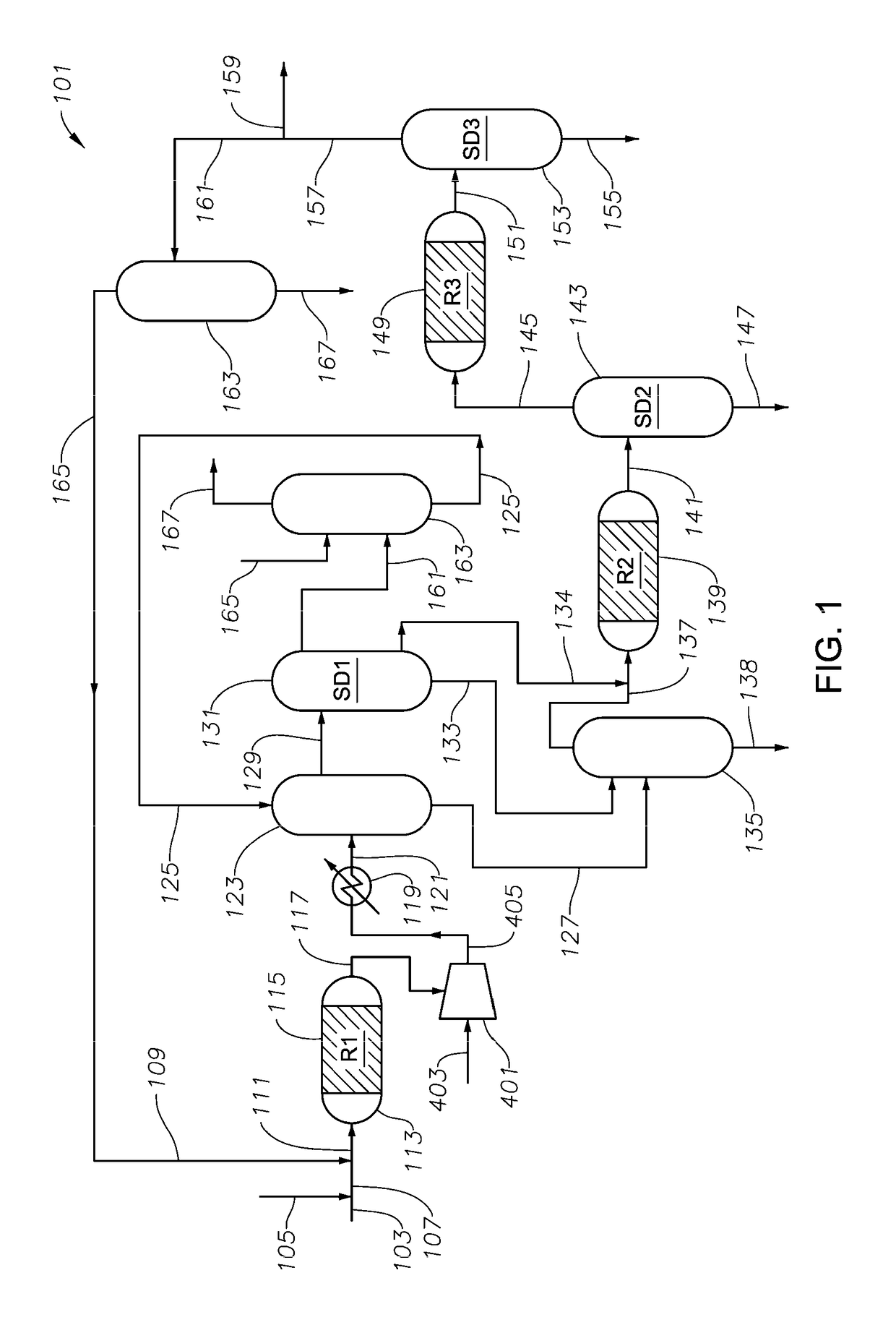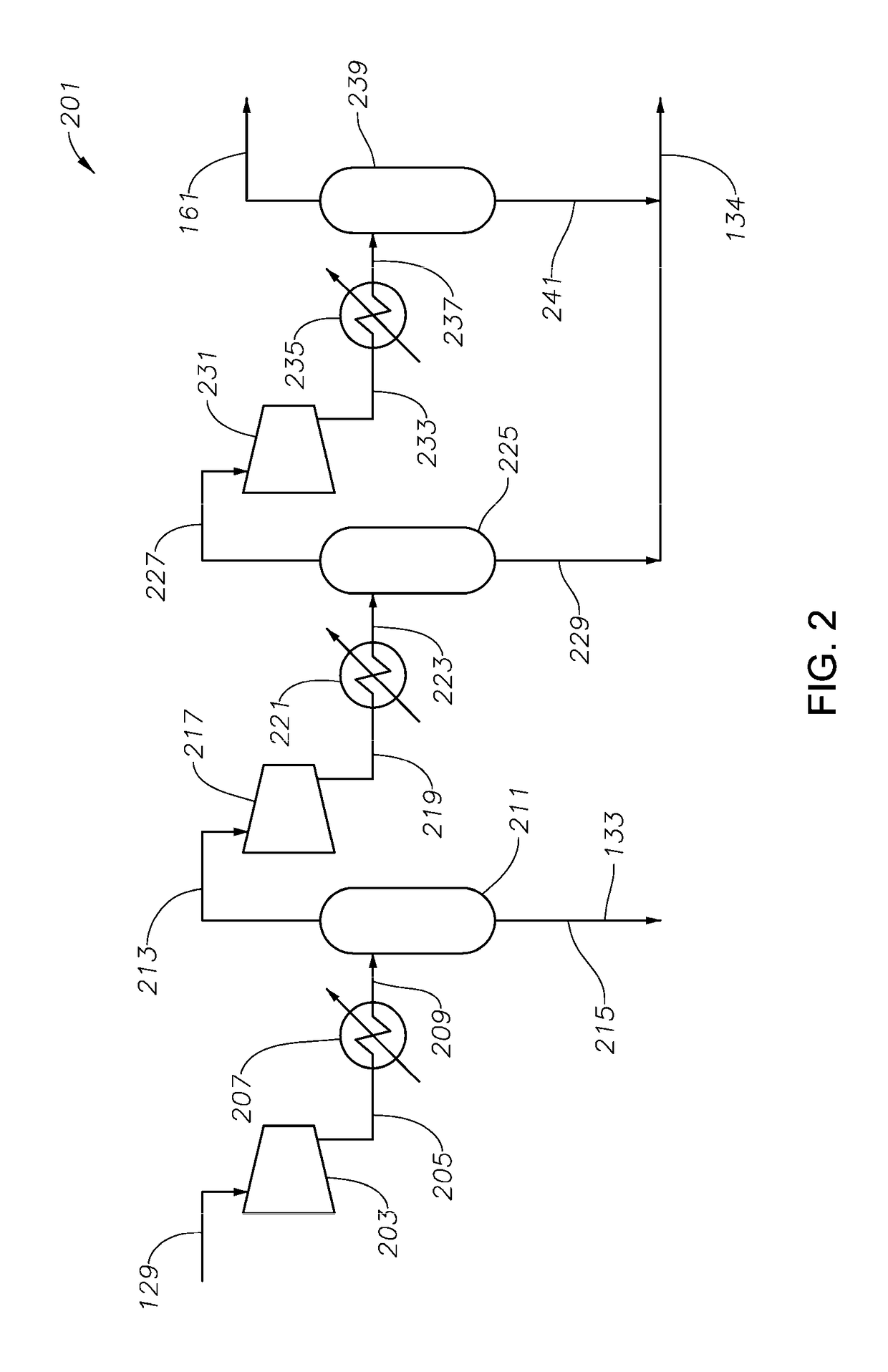Process and system for making cyclopentadiene and/or dicyclopentadiene
a technology of dicyclopentadiene and cyclopentadiene, which is applied in the field of process and system for making cyclopentadiene and/or dicyclopentadiene, can solve the problems of loss of catalyst activity, processing is needed, and many challenges in designing an on-purpose cpd production process, so as to achieve low partial pressure of cpd and/or hydrogen, increase the overall pressure of the product stream, and effective separation
- Summary
- Abstract
- Description
- Claims
- Application Information
AI Technical Summary
Benefits of technology
Problems solved by technology
Method used
Image
Examples
example 1
[0192]In this example, a first reactor effluent produced from pure n-pentane feedstock, a pure hydrogen co-feedstock with 1:2 hydrogen / n-pentane molar ratio, without co-feeding a light hydrocarbon or recycling of any down-stream C5-rich fractions to the first reactor. The process temperature, pressure, and molecular weight at the reactor inlet are 475° C., 62 psia (401.9 kilopascal absolute), and 49.01 g / mol, respectively. Temperature and pressure at the reactor outlet are 575° C. and 10 psia (68.9 kilopascal absolute), respectively. The reactions generate an additional 1.87 moles of molecules in the first reactor effluent exiting the outlet per mole of molecules in the total feed material at the inlet. This 1.87-fold molar expansion has the effects of lowering the molecular weight and density of the stream mixture from 49.01 g / mol at the inlet to 27.05 g / mol at the outlet and from 3.08 kg / m3 at the inlet to 0.26 kg / m3 at the outlet, respectively. The pressure drop from the inlet to...
example 2
[0195]The reactor inlet and outlet temperature and pressure remain the same as in Example 1 above. However, in this example, a C5-rich stream, produced as 35% of the third C5-rich fraction obtained by separating the third reactor effluent produced from a second dimerization reactor described above, is recycled to the first reactor, where it is admixed with n-pentane before being fed into the first reactor. Hydrogen is co-fed at H2 / (all C5 hydrocarbons except (iso-C5 hydrocarbons and CPD)) molar ratio of 1:2. It has been experimentally found that the reaction pathway from iso-C5 hydrocarbons to CPD is kinetically inhibited under the reaction conditions. The composition of the total feed to the first reactor is given in Table I below.
[0196]The remaining 65% of the third C5-rich fraction is used as a mogas blend for making mogas. The composition of the mogas blend is provided in Table I below as well.
[0197]In this example, to produce 100 tons of CPD in stream 117, a total weight of 308...
example 3
[0204]In this prophetic example, obtained by simulation, a model third C5-rich fraction used as the mogas blend and a corresponding partially hydrogenated mogas component having the following compositions in Table II can be obtained:
[0205]
TABLE IIConcentration in (wt %)Third C5-richPost-SelectiveComponentsFractionHydrogenationPropylene0.220.22Propane0.270.27Isobutane0.000.00Isobutylene0.140.141-butene0.750.811,3-butadiene0.210.00n-butane0.910.91t-2-butene0.951.01c-2-butene0.720.793-methyl-1-butene0.070.071,4-pentadiene0.070.00Isopentane0.340.341-pentene6.369.112-methyl-1-butene0.300.32Isoprene0.050.00n-pentane52.5952.59t-2-pentene12.5415.21c-2-pentene7.089.752-methyl-2-butene0.540.56Cyclopentadiene0.440.00t-1,3-pentadiene4.410.00c-1,3-pentadiene3.610.00Cyclopentene5.545.98Cyclopentane0.900.90Benzene1.011.01C10 (dimers)0.000.00Total100.00100.00
PUM
| Property | Measurement | Unit |
|---|---|---|
| temperature | aaaaa | aaaaa |
| pressure | aaaaa | aaaaa |
| temperature | aaaaa | aaaaa |
Abstract
Description
Claims
Application Information
 Login to View More
Login to View More - R&D
- Intellectual Property
- Life Sciences
- Materials
- Tech Scout
- Unparalleled Data Quality
- Higher Quality Content
- 60% Fewer Hallucinations
Browse by: Latest US Patents, China's latest patents, Technical Efficacy Thesaurus, Application Domain, Technology Topic, Popular Technical Reports.
© 2025 PatSnap. All rights reserved.Legal|Privacy policy|Modern Slavery Act Transparency Statement|Sitemap|About US| Contact US: help@patsnap.com



